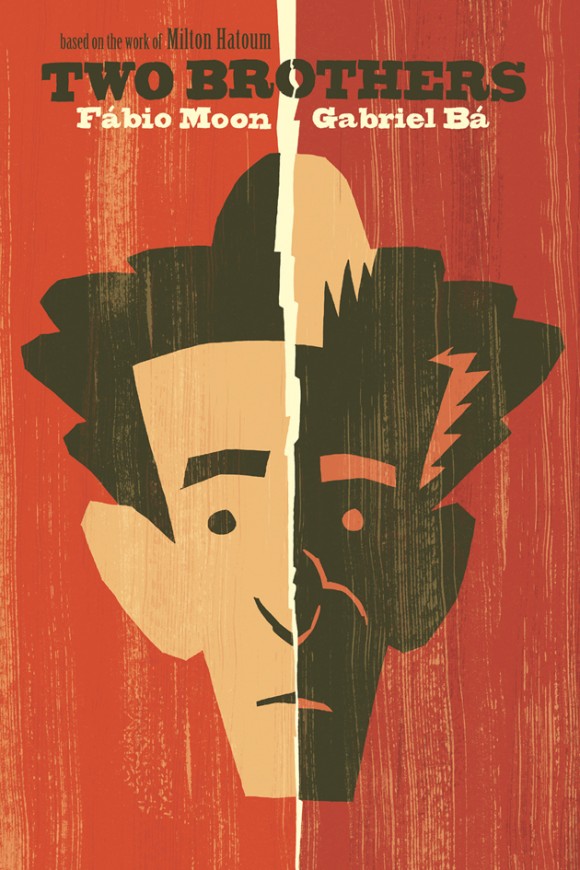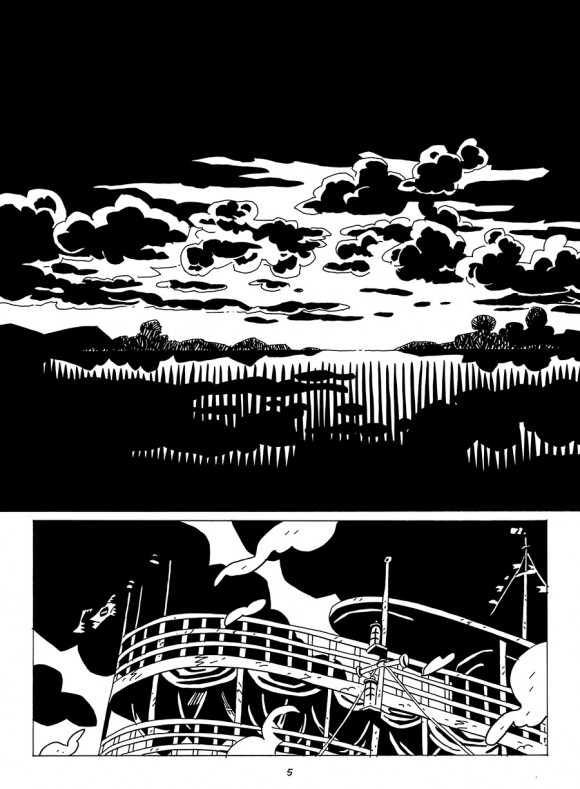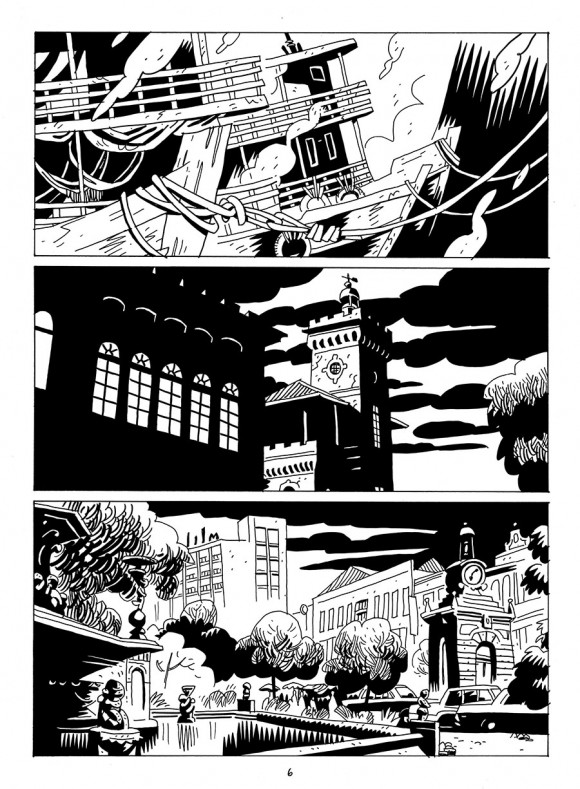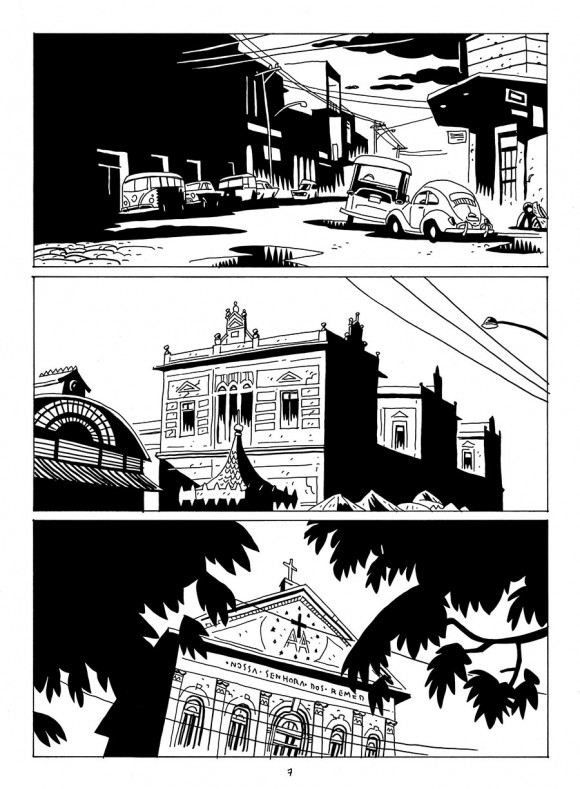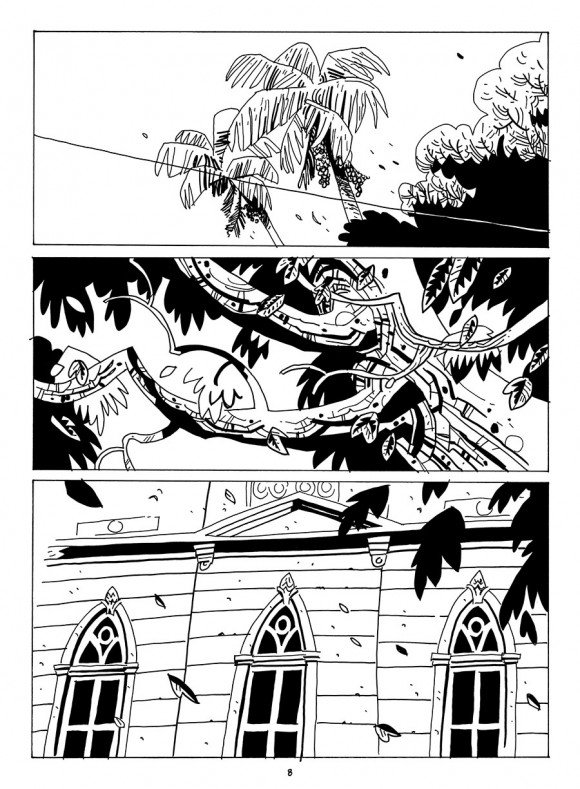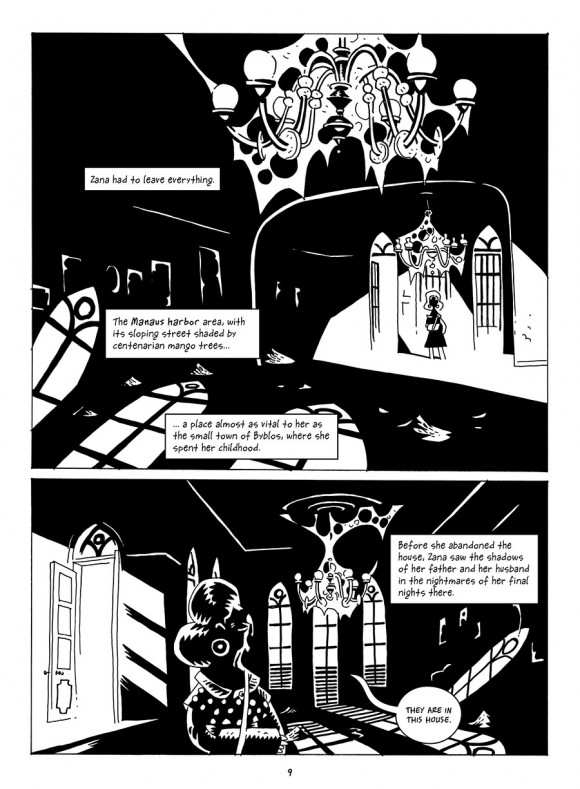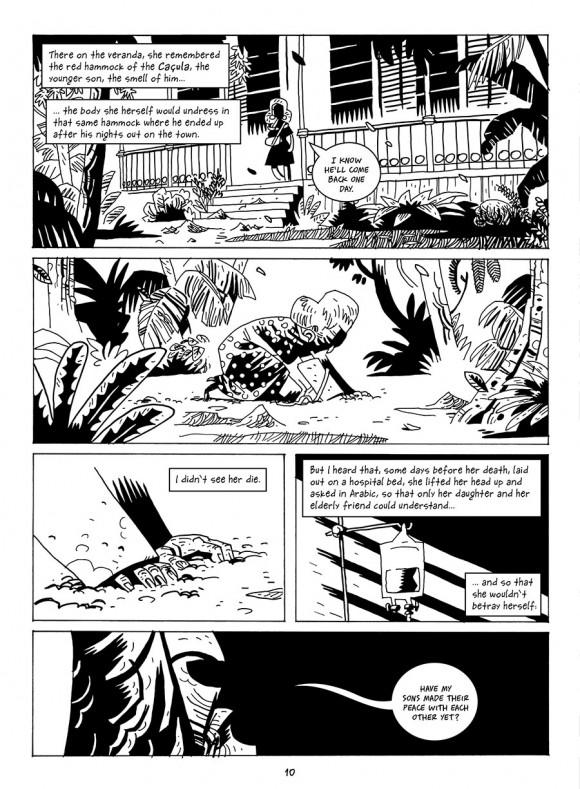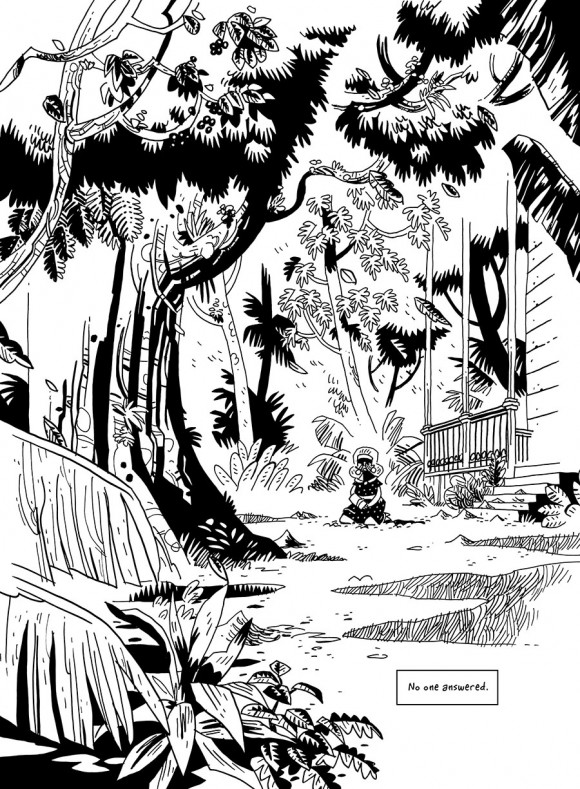Twin brothers Fabio Moon and Gabriel Bá talk about their new graphic novel Two Brothers, a compelling narrative about generational growth in Brazil throughout the 20th century.
—
By G.D. KENNEDY
It is probably safe to say that the term “graphic novel” is abused in the comics industry, applied to just about any trade paperback or other collections of comics without regard for the concept of completeness that is associated with a novel. However, the term couldn’t be more appropriately applied than to Two Brothers, the most recent work by Fabio Moon and Gabriel Bá, which is scheduled for release by Dark Horse on 10/14.
This book, which is an adaptation of the prose novel The Brothers by famed Brazilian author Milton Hatoum, is a self-contained work, exploring the rise and fall of a family in Brazil throughout the 20th century, examining the strains of family ties against an ever-evolving backdrop of a country and world in transition. The book itself feels much more like a novel than a traditional comic, as it moves with an effortless but deliberate pacing that is coupled with a gravitas that lends itself to a distinctly literary feel. It’s all aided by stunning artwork from Ba, who relies on heavy black-and-white inks that constantly play with light and shadows to set the story’s tone.
Ba and Moon were good enough to talk to us about Two Brothers; if you’re interested in hearing them for yourself, you’ll have two chances this week in NYC: First at Barnes & Noble in Tribeca (97 Warren Street) at 7:00 p.m. on 10/7, and then appearing at their own panel, Spotlight on Gabriel Moon and Fábio Bá: Different is Cool on 10/10 at 11:00 a.m. at New York Comic Con, Room 1A18.
—–
G.D. Kennedy: Can you briefly tell us what Two Brothers is about?
Gabriel Moon: On one level, this is a story of two twin brothers who had a quarrel when they’re young and how this event affects their lives and the lives of their whole family.
Fábio Bá: On another level, this is a story about how do we adapt when our world is changing.
G.D.: Two Brothers is an adaptation of the novel “The Brothers” by Milton Hatoum. Why did you choose this book? What did it mean for you personally to adapt this book?
Fábio: We were invited by the Brazilian publisher of the novel to adapt this story. At first, we didn’t want to engage in a book adaptation, specially a book of this size and complexity, but we realised it carries every element we like to tell in our own stories.
Gabriel: This is a story about family, about human relations, about the consequences of our actions and how they affect the lives of people around us. Also, it’s a story set in Brazil, but a completely different Brazil than the one we usually portray. And most importantly: it was our chance to tell a great tragedy.
Fábio: We don’t see stories like this in comics very often. The drama, the pacing, the complexity. It was a challenge that inspired us.
G.D.: How did you go about adapting the novel to fit a graphic format? What steps did you have to take to translate the story into a graphic novel?
Fábio: We spent over two years working only on the script of the graphic novel. We wrote a few synopsis of the book to understand the story, trying to decide which were the most important parts of it, the key moments. We made a timeline of the whole story, lists of characters, places, names of plants and animals that appeared throughout the book. Every new synopsis was a little trimmed, focused on what we felt important, pointing to how we wanted to tell the story and eventually with sequences of text we wanted to include in the book.
Gabriel: After accepting that there was no reason to write a regular comic book script with page and panel descriptions, we decided to write a “layout script”, drawing layouts of the pages and hand writing the texts directly in it. It’s a hard way to do it because all the decisions are made at that stage: storytelling decisions of how to set your page; what part of the text will get in as narration on captions; what’s going to be turned into dialogue; and all the drawing decisions, like composition, pacing, rhythm and silence scenes. Even though it’s on a very sketchy stage, you end up with all the important information for the story on those layout pages. After we were done, it was like we had the whole book in front of us.
G.D.: Did you consult with Milton Hatoum in the process of creating this book? If so, what was his reaction to the adaptation, and his role?
Gabriel: After reading and re-reading the book a few times, we knew we had to travel to Manaus to do research for the book, to get to know the city and understand a little better the universe of the story. We met with Milton and asked for some tips and he was incredibly helpful, pointing us which places mentioned in the book are still there, which ones had their names changed and which ones were gone. He also put us in touch with a friend of his, a big enthusiast of the culture of the Amazon region, who was of great help around the city, also getting us history books and old postcards.
Fábio: Milton is very humble and has no feelings of possession over the book. He knew our work and trusted us completely to do our adaptation. At the same time, we didn’t want to reach out for him all the time to discuss the story, we wanted to trust our guts and tell the story we felt was right.
Gabriel: We contacted him one more time, two years into production, to ask for his opinion when we did the first sketches of the characters. He loved them all, except for Zana, who he pictured differently. We talked a little about the character, he showed us some old family pictures of his mother and grandmother and this conversation was hugely important for us to understand Zana’s role in the story.
Fábio: After this meeting, we only sent him parts of the story as they were getting done. The first chapter at one point. The second one a few months later. Then finally the whole story a year later.
G.D.: There’s a very personal, familiar feel to this story. What was it about this story that made it so important to you? How did you make this story your own, despite the fact that it is an adaptation?
Gabriel: When we were first invited to do this adaptation, we didn’t really want to do it, because we make a big effort to tell our own stories, to show people – especially in Brazil – that you can tell any kind of stories with comic books. But after reading the book and getting completely overwhelmed by the story, we actually noticed how it fit perfectly to what we wanted to accomplish. It was a deep and intense story talking about relationships, choices and consequences. A great story that forces the reader to reflect about society and life, one that’s worth telling to as many people as possible. In the end, we felt this project was tailor made for us.
G.D.: I think in reading this book, there is an immediate parallel between the titular brothers, who are twins, and both of you. Obviously you two have a far better relationship than Yaqub and Omar, but what was it like writing and drawing these characters who had some very real similarities to you, but also such extreme differences? Did this force you to explore your relationship to each other at all?
Gabriel: The fact that we are twins is what got us into this project, it’s true. The editor saw us on a literary festival in Brazil talking to Milton, the novel’s author, and got this brilliant idea of the adaptation. Very obvious and shallow at first, but this idea would not have been suggested to another cartoonist, just for the sake of doing an adaptation. It only would make sense if we as twins were making it. But that’s as far as it goes.
Fábio: Indeed, the twins from the story are completely different from us, but we do understand how everyone else around twin brothers act, how they relate to twins, always assuming they are the same person or that they have the same opinion on everything. Because of that, we knew very well how to play the tension between the twins and the rest of the family throughout the book, how the quarrel between the twins affected all the other members of the family.
G.D.: One of my favorite parts of the book is how it tells the history of 20th century Brazil, both through the evolution of Manaus and as reflected through the characters. Why was this something so important for you to tell?
Gabriel: This story has several layers to it, and one of them talks about Brazilian history and how it affected the lives of people around the country, specially in Manaus and that region. Not only the lives of people were changing as the years passed, history was being written, choices being made, violently erasing the past.
Fábio: The book is not didactic, we’re not teaching history and the main focus is on the characters and their lives. But the historical background gives it more depth and shines a light on the subject of progress, changes that come from time and also from external forces. It’s good to talk about these subjects and make the modern reader reflect about them, think about their world in the present and see what’s changed and what remains the same.
G.D.: The book has a focus on the immigration, the changing demographic of migrants to Brazil over the past century, and the attitudes directed towards migrants. Obviously, with the current refugee crisis, immigration is a prevalent issue today. Why did you decide to to explore this aspect of Brazil’s history?
Fabio: This is just one other reason why we loved this story so much, the fact it forces us to reflect about these issues. Who is your family? Where is your home? The migration issue is as relevant today as it ever was. Where does one belong? What does it take for someone to leave their home and adventure themselves into a foreign place? What are the consequences of leaving your country behind, or being forced to leave. What life will you live from that point on?
Gabriel: The places were more isolated from each other in the past and every distance seemed farther. Nowadays, we live in a globalized world, and we should be breaking frontiers and barriers, gaining from this exchange. However, there is a strange conservative wave all around the country – and the world – that fears and fights these migration movement. We should be helping each other.
G.D.: One of the things that I enjoyed about the graphic novel was that it retained a very literary feel. The pacing and dialogue moved much more like a contemporary novel, instead of a graphic novel. Was this something that you set out for? How did you accomplish this?
Fábio: We love the power of words, how you can leave such an impression on someone by telling a story the right way. It’s the gift of storytelling, of using the language. One of our concerns when adapting the novel was to try to respect the original author’s voice, the writing style. Milton has an enchanting style that helps the story, gives it personality and strength. One of the biggest challenges of this adaptation was trying to keep this writing as much as we could, at the same time that we would ad the visual aspect of the storytelling and other tools that the language has to offer. We had to balance the narration with dialogues and moments in complete silence, so the story wouldn’t get too slow or sound like an illustrated tale.
G.D.: As I understand it, Two Brothers was a work that took considerable time — a number of years — and effort to perfect. What went into creating this book? What the process of researching for this book?
Fábio: Since the book is long and complex, we knew from the start we couldn’t have any sort of deadline. Once the work is done, it doesn’t matter how long it took you to make it. All that really mattered was to make the best work possible. Of course we couldn’t commit to this project alone for four years. We were still working on Daytripper when we got invited to do Two Brothers, but we only started a little after we finished the series. We already had a couple of other projects lined up – B.P.R.D.: Vampire and Casanova: Avarita – which we did from 2011 until 2013.
Gabriel: During these first two years juggling several projects, we worked only on the script of Two Brothers, getting deeper into the book, understanding the story. But two years without drawing actual pages was driving us insane, it was too abstract. That’s when we sketched the first characters and began drawing the actual pages. After 2013, when all other projects were over, I committed myself only to finishing this book, which only happened in September of 2014.
G.D.: From a technical standpoint, you both have backgrounds as illustrators and writers. Reading the book, the style is clearly one artist — Gabriel, right? How did you decide who would draw? Was the art still a collaborative process throughout?
Gabriel: Both of us can write and draw, we have lots of the same influences and have a great understanding of what we want to tell, but there’s always a limit to what we can do together on a project, what we have to split between us and what we have to do on our own.
Fábio: Writing is the part of the process we can collaborate more, we talk about the story, about the paths it will take, what will happen, what the characters will do or say, how to take the story to where we want it to go and so on. Then when it comes to drawing, we have different art styles and we have, on a ideal world, to choose which style fits best with the story we’re going to tell. Or we can do the opposite, which was what happened with Two Brothers.
Gabriel: Since Fábio had drawn Daytripper, we knew our next big and personal project would be something I would like to draw. So when they invited us to adapt this book, only after I read it and fell in love with it, we finally decided we wanted to get into this project.
G.D.: What’s next on the horizon for you two? Any more collaborative books in the works?
Fábio: I’m currently working on Casanova with Matt Fraction, with backup stories written by Michael Chabon and drawn by Bá.
Gabriel: I’ve also just started working on Hotel Oblivion, the third series of The Umbrella Academy with Gerard Way.
Fábio: Between these two projects and promoting Two Brothers, we have no time or mind to do anything else at the moment. We have some ideas, but for later on the road. We have no hurry.

